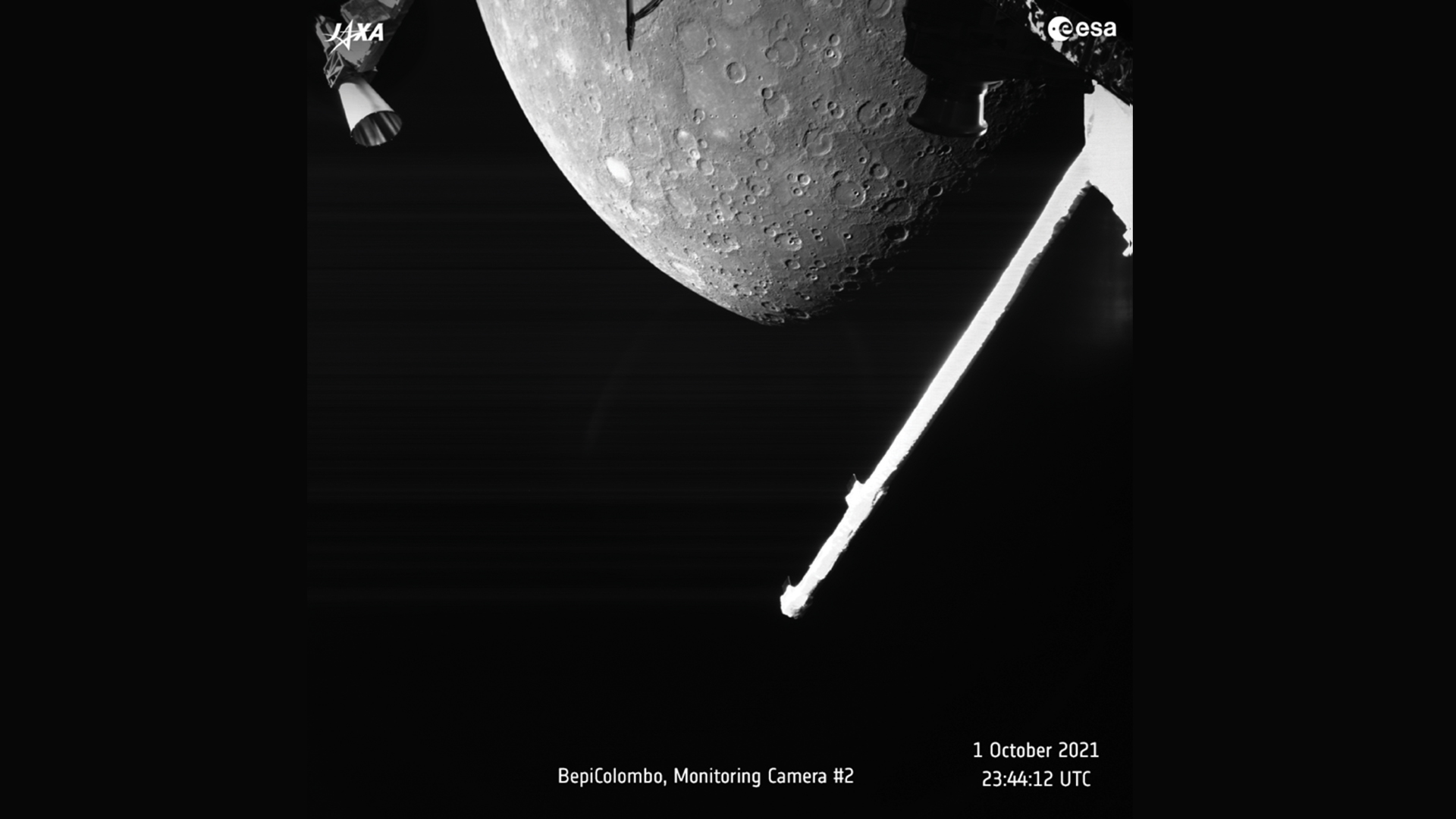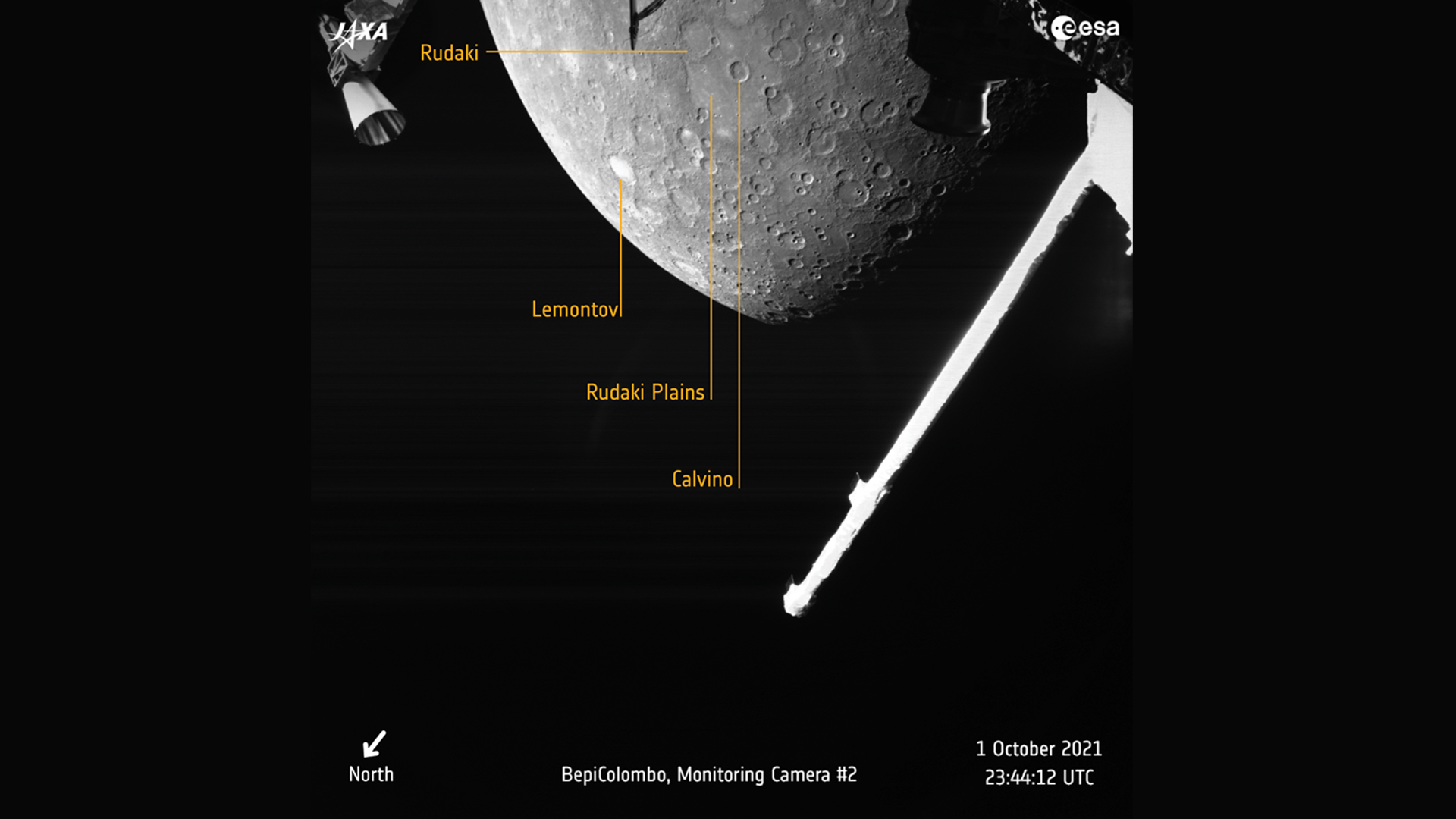Mercury looks stunning in this 1st flyby photo from Europe and Japan's BepiColombo mission
It's the first of six Mercury flybys before BepiColombo enters orbit in 2025.

Two spacecraft built by Europe and Japan captured their first up-close look at the planet Mercury in a weekend flyby, revealing a rocky world covered with craters.
The two linked probes, known together as BepiColombo, snapped their first image of Mercury late Friday (Oct. 1) during a flyby that sent them zooming around the planet. The encounter marked the first of six Mercury flybys for BepiColombo, a joint effort by the space agencies of Europe and Japan, to slow itself enough to enter orbit around the planet in 2025.
BepiColombo took its first official photo of Mercury at 7:44 p.m. EDT (2344 GMT) with its Mercury Transfer Module Monitoring Camera 2, a black-and-white navigation camera, as the probe was about 1,502 miles (2,418 kilometers) away from the planet, according to the European Space Agency (ESA). Just 10 minutes earlier, at 7:34 p.m. EDT, BepiColombo made its closest approach to Mercury, passing within 124 miles (200 km) of the planet.
Related: BepiColombo in pictures: A Mercury trip by Europe and Japan
Dozens of craters are visible on the surface of Mercury in BepiColombo's photo, as are a boom, thruster and other parts of the spacecraft's structure.
"The region shown is part of Mercury's northern hemisphere including Sihtu Planitia that has been flooded by lavas. A round area smoother and brighter than its surroundings characterizes the plains around the Calvino crater, which are called the Rudaki Plains," ESA officials wrote in a photo description. "The 166 km-wide Lermontov crater is also seen, which looks bright because it contains features unique to Mercury called 'hollows' where volatile elements are escaping to space. It also contains a vent where volcanic explosions have occurred."
ESA also released an annotated image identifying the major Mercury craters in BepiColombo's image alongside the raw photo. More photos are expected to be released in coming days as they are processed by BepiColombo's science team.
Get the Space.com Newsletter
Breaking space news, the latest updates on rocket launches, skywatching events and more!
Related: The most enduring mysteries of Mercury

The $750 million BepiColombo mission consists of two different orbiters designed to study Mercury in unprecedented detail with a total of 16 different instruments. ESA's contribution is the Mercury Planetary Orbiter to study the planet from above while the Mercury Magnetospheric Orbiter, built by the Japan Aerospace Exploration Agency, will study the planet's magnetic field, plasma environment and dust.
The two orbiters are riding to their target planet on the Mercury Transfer Module on a seven-year trip that began with a launch in 2018. So far, BepiColombo has successfully made four flybys of three different planets: one of Earth in April 2020, two of Venus (in October 2020 and August 2021) and now one of Mercury.
The next Mercury flyby is scheduled for June 20, 2022 and will be followed by four more flybys in June 2023, September and December of 2024, and January 2025. If all goes well, BepiColombo is expected to enter orbit around Mercury on Dec. 5, 2025.
Email Tariq Malik at tmalik@space.com or follow him @tariqjmalik. Follow us @Spacedotcom, Facebook and Instagram.
Join our Space Forums to keep talking space on the latest missions, night sky and more! And if you have a news tip, correction or comment, let us know at: community@space.com.

Tariq is the Editor-in-Chief of Space.com and joined the team in 2001, first as an intern and staff writer, and later as an editor. He covers human spaceflight, exploration and space science, as well as skywatching and entertainment. He became Space.com's Managing Editor in 2009 and Editor-in-Chief in 2019. Before joining Space.com, Tariq was a staff reporter for The Los Angeles Times covering education and city beats in La Habra, Fullerton and Huntington Beach. In October 2022, Tariq received the Harry Kolcum Award for excellence in space reporting from the National Space Club Florida Committee. He is also an Eagle Scout (yes, he has the Space Exploration merit badge) and went to Space Camp four times as a kid and a fifth time as an adult. He has journalism degrees from the University of Southern California and New York University. You can find Tariq at Space.com and as the co-host to the This Week In Space podcast with space historian Rod Pyle on the TWiT network. To see his latest project, you can follow Tariq on Twitter @tariqjmalik.









